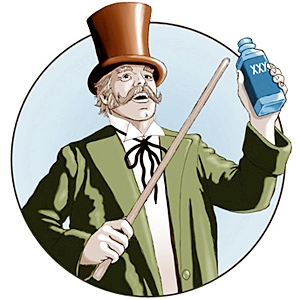
As a lifelong lover of all things drawn — comic strips, comic books, graphic novels, cartoons and animated films — there’s an argument that the neo-prohibitionist wingnuts make from time to to time that absolutely frys my bacon. And they’re at it again. The increasingly neo-prohibitionist group Alcohol Justice (AJ) is unhappy once more with Anheuser-Busch InBev (are they ever happy?), this time because they’re using — gasp! — cartoons to promote their association with the Ultimate Fighting Championship (UFC). In Bud Light and UFC Push Beer to Kids with Comics, AJ makes the same tired argument they always do whenever anybody uses an image that’s been drawn in an advertisement. Here’s how they put it this time:
So how does a company that says it’s committed to not advertising to kids choose to spend millions of its marketing dollars? Get this: comic strips, posted on Facebook, targeting fans of mixed-martial arts fighting, also known as Ultimate Fighting Championships. As the primary sponsor of the brutal and offensive UFC, A-B InBev gets the Bud Light logo delivered directly to the computer screens of millions of kids worldwide. Moreover, they use the quintessential child-friendly format of comic strips to do it. The only way they could top this direct advertising to youth is if they plastered Sponge Bob SquarePants’ picture on Bud Light cans.
Well get this, comic strips and other animated fare is NOT JUST FOR KIDS. They never, ever have been. Yes, there are cartoons aimed at kids, but many, many are either for all ages or are for more mature people. People able to separate content from delivery, something that AJ is apparently incapable of, understand this. The folks that come up with these arguments must be the least fun people to be around, if they avoid anything that’s been animated because they believe it must be for kids only. Think what they’re missing.
But just a short history should convince even the most jaded neo-prohibitionist that comics have long been for all ages, and many were aimed at adults since they were first created. The very first comic strip, The Yellow Kid, began in newspapers in the last decade of the 19th century. It tackled social and political topics, and was for the adults who read newspapers. The first animated film, Gertie the Dinosaur, created by Windsor McCay in 1914, was similarly not exclusively kiddie-fare. McKay used it in his vaudeville act, which was not for kids.
All those Looney Toons, Tom & Jerry’s, Popeye’s and other cartoons we grew up watching Saturday mornings and after school began as the cartoon shown before the main attraction started at movie theaters. And we’re not talking about kiddie files, but all films. They were aimed at either the adults there to see an adult film or were for all ages (Disney being exception and the prime example of a studio that did more family-friendly stuff). That’s why there are lots of old Warner Brothers cartoons (and others) that are never shown on television when they repackaged them for TV, because their subject matter is seen as inappropriate for today’s youth.
Comic books in the 1950s covered a wide range of subjects, not just superheroes, but another wingnut wrote “Seduction of the Innocent,” a deeply flawed book that equated violence with reading comic books, and comic books were reduced to only kid-friendly stories (at least until the 1980s).
Try to watch Rocky & Bullwinkle or Beany & Cecil and not see all the adult political references. You’d have to be utterly clueless to not see that cartoons have never been the exclusive realm of children. Many mature adults love cartoons now, and have since people first started drawing them.
That AJ and other anti-alcohol folks claim this is, for me, more proof of how they’re willing to bend the truth, and common sense, to push their agenda. I don’t even like the UFC, or any type of fighting sports like boxing, etc. (except for the NFL), but just because they use a comic strip promoting it does not ipso facto mean they’re targeting kids. You’d have to be a child yourself to make, or swallow, that line of reasoning.
Another interesting tactic that AJ uses again here is claiming they’re not the only one outraged, when they state that “Culinary Workers Union recently sent a forceful letter to A-B InBev expressing disgust at the company’s ‘socially irresponsible behavior.'” Except that when you look at this letter, it’s also signed by AJ’s executive director Bruce Lee Livingston, meaning it’s more likely AJ’s letter, or at a minimum a joint letter. But that fact is conveniently left out of their press release, most likely because it would weaken their already questionable argument. As I said, I’m no fan of the UFC, or similar spectacles, and I tend to believe the world would be a better place if people didn’t enjoy violence quite so much, but any meaningful public discussion has to start by being honest. And starting that discussion by claiming that if anybody uses a cartoon then they’re only targeting kids, is hardly honest. Now I need a beer, and the Simpsons is on.










